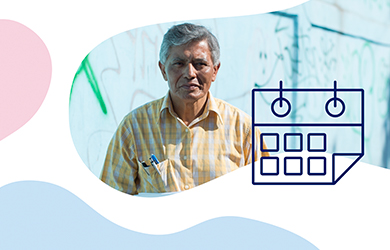
How to make a simple plan for managing type 2 diabetes
Being diagnosed with type 2 diabetes can feel like a setback. But identifying the problem brings you closer to the solution. Here are some tips to get started.
Glucagon-like peptide 1 (GLP-1) is a naturally occurring hormone in the body that has a number of benefits, particularly for people with type 2 diabetes1.
Therefore, GLP-1 RA (receptor agonist) treatments have been developed to mimic the function of the GLP-1 hormone and increase its effect as it occurs in people without type 2 diabetes1, 2.
GLP-1 RA is a class of non-insulin medication that assists your body’s natural ability to regulate blood sugar and appetite2.
Take the quiz to find out how much you know about type 2 diabetes and GLP-1 RAs.
Millions of people are living with diabetes worldwide, approximately 90% of whom live with type 2 diabetes5. Despite its prevalence, many myths still persist. At Novo Nordisk, we're committed to improving awareness and treatment for everyone at risk of diabetes across the globe.
It is also important to manage weight, diet and exercise[6].
As a progressive disease, medication is often required[6,7].
Some treatments can also reduce the risk of heart disease[7,8].
People with type 2 diabetes are at higher risk of cardiovascular disease with 1 in 3 people with type 2 diabetes developing cardiovascular disease[9].
Insulin is just one of many types of diabetes treatments[7].
You learn more from defeat than victory! Better luck next time.
Not bad at all! Still some room for improvement.
You're an expert mythbuster! Time to challenge your friends.
Correct
While managing blood sugar levels is very important in diabetes, it is also important to measure indicators of related risk factors. Regular checks of blood pressure (BP) and blood cholesterol (LDL-c) levels are also key to a diabetes management plan[6].
Correct
Type 2 diabetes is a progressive disease, meaning your condition will evolve over time. And faster if left untreated. While diet and exercise can help stabilise your condition, at some stage, diabetes will require prescribed medication to help balance your metabolism and blood sugar[6,7].
Correct
There are several different treatment approaches for type 2 diabetes. Most help control blood sugar levels, but they can also help with weight management and help manage long term complications that arise from type 2 diabetes[6,7].
Correct
People living with type 2 diabetes face higher risk of cardiovascular disease, even if symptoms aren't apparent[8,9]. Ask your doctor about glucose-lowering, cardio-protective treatment options.
Correct
Type 2 diabetes tends to progress over time,. and there are many different options out there for each stage of the disease[6].
SG25DI00057